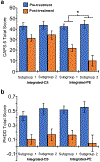Resting-state connectivity subtype of comorbid PTSD and alcohol use disorder moderates improvement from integrated prolonged exposure therapy in Veterans
- PMID: 33926595
- PMCID: PMC10880798
- DOI: 10.1017/S0033291721001513
Resting-state connectivity subtype of comorbid PTSD and alcohol use disorder moderates improvement from integrated prolonged exposure therapy in Veterans
Abstract
Background: Posttraumatic stress disorder (PTSD) and alcohol use disorder (AUD) are highly comorbid and are associated with significant functional impairment and inconsistent treatment outcomes. Data-driven subtyping of this clinically heterogeneous patient population and the associated underlying neural mechanisms are highly needed to identify who will benefit from psychotherapy.
Methods: In 53 comorbid PTSD/AUD patients, resting-state functional magnetic resonance imaging was collected prior to undergoing individual psychotherapy. We used a data-driven approach to subgroup patients based on directed connectivity profiles. Connectivity subgroups were compared on clinical measures of PTSD severity and heavy alcohol use collected at pre- and post-treatment.
Results: We identified a subgroup of patients associated with improvement in PTSD symptoms from integrated-prolonged exposure therapy. This subgroup was characterized by lower insula to inferior parietal cortex (IPC) connectivity, higher pregenual anterior cingulate cortex (pgACC) to posterior midcingulate cortex connectivity and a unique pgACC to IPC path. We did not observe any connectivity subgroup that uniquely benefited from integrated-coping skills or subgroups associated with change in alcohol consumption.
Conclusions: Data-driven approaches to characterize PTSD/AUD subtypes have the potential to identify brain network profiles that are implicated in the benefit from psychological interventions - setting the stage for future research that targets these brain circuit communication patterns to boost treatment efficacy.
Keywords: Alcohol use disorder; PTSD; biomarkers; fMRI; network connectivity; treatment prediction.
Conflict of interest statement
CONFLICT OF INTEREST STATEMENT
All authors declare no conflicts of interest.
Figures



Similar articles
-
Efficacy of Integrated Exposure Therapy vs Integrated Coping Skills Therapy for Comorbid Posttraumatic Stress Disorder and Alcohol Use Disorder: A Randomized Clinical Trial.JAMA Psychiatry. 2019 Aug 1;76(8):791-799. doi: 10.1001/jamapsychiatry.2019.0638. JAMA Psychiatry. 2019. PMID: 31017639 Free PMC article. Clinical Trial.
-
Subgroups of comorbid PTSD and AUD in U.S. military veterans predict differential responsiveness to two integrated treatments: A latent class analysis.J Psychiatr Res. 2021 May;137:342-350. doi: 10.1016/j.jpsychires.2021.02.061. Epub 2021 Mar 13. J Psychiatr Res. 2021. PMID: 33756376 Clinical Trial.
-
ALTERED DEFAULT MODE NETWORK (DMN) RESTING STATE FUNCTIONAL CONNECTIVITY FOLLOWING A MINDFULNESS-BASED EXPOSURE THERAPY FOR POSTTRAUMATIC STRESS DISORDER (PTSD) IN COMBAT VETERANS OF AFGHANISTAN AND IRAQ.Depress Anxiety. 2016 Apr;33(4):289-99. doi: 10.1002/da.22481. Depress Anxiety. 2016. PMID: 27038410
-
Behavioral Treatments for Alcohol Use Disorder and Post-Traumatic Stress Disorder.Alcohol Res. 2018;39(2):181-192. Alcohol Res. 2018. PMID: 31198657 Free PMC article. Review.
-
Treatment of alcohol use disorder and co-occurring PTSD.Am J Drug Alcohol Abuse. 2017 Jul;43(4):391-401. doi: 10.1080/00952990.2016.1263641. Epub 2016 Dec 23. Am J Drug Alcohol Abuse. 2017. PMID: 28010130 Review.
Cited by
-
Spontaneous brain activity, graph metrics, and head motion related to prospective post-traumatic stress disorder trauma-focused therapy response.Front Hum Neurosci. 2022 Aug 12;16:730745. doi: 10.3389/fnhum.2022.730745. eCollection 2022. Front Hum Neurosci. 2022. PMID: 36034114 Free PMC article.
-
Understanding Pain and Trauma Symptoms in Veterans From Resting-State Connectivity: Unsupervised Modeling.Front Pain Res (Lausanne). 2022 May 10;3:871961. doi: 10.3389/fpain.2022.871961. eCollection 2022. Front Pain Res (Lausanne). 2022. PMID: 35620636 Free PMC article.
-
PTSD subtypes and their underlying neural biomarkers: a systematic review.Psychol Med. 2025 May 22;55:e153. doi: 10.1017/S0033291725001229. Psychol Med. 2025. PMID: 40400453 Free PMC article. Review.
-
Neural connectivity biotypes: predictors of clinical outcomes and improvement patterns of iTBS treatment in adolescents and young adults with depression.Gen Psychiatr. 2025 Apr 28;38(2):e101749. doi: 10.1136/gpsych-2024-101749. eCollection 2025. Gen Psychiatr. 2025. PMID: 40303882 Free PMC article.
-
Individualized resting-state functional connectivity abnormalities unveil two major depressive disorder subtypes with contrasting abnormal patterns of abnormality.Transl Psychiatry. 2025 Feb 6;15(1):45. doi: 10.1038/s41398-025-03268-9. Transl Psychiatry. 2025. PMID: 39915482 Free PMC article.
References
Publication types
MeSH terms
Grants and funding
LinkOut - more resources
Full Text Sources
Other Literature Sources
Medical

